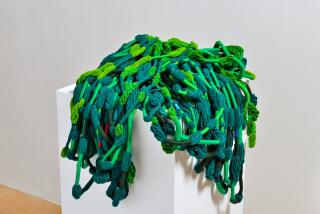‘Kente: a Special Cloth for Special Occasions’
- Share via
The UCLA Fowler Museum of Cultural History and Crenshaw High School have developed a museum studies project called “Wrapped in Pride: Ghanaian Kente and African American Identity.” Crenshaw High students, under the tutelage of museum faculty, study the artistic and cultural significance of African textiles--particularly Ghanaian kente cloth--among African Americans. Their findings will be included in a catalog for an upcoming Fowler exhibit. Kente is a ceremonial cloth that comes in various colorful patterns. It is manufactured mainly by weavers in a south Ghanaian village called Bonwire.
BRETT ANTHONY COLLINS visited Crenshaw High to ask some of the students their feelings about kente cloth and its artistic, political and cultural importance.
HAVONNAH WILLS
Crenshaw High School junior
I took the museum studies class because I wanted to do something different. I’ve always taken art classes and I’m into clothes. In this class, I’ve learned that there are four different types of kente cloth: print (silk-screen), machine-made, handmade and loom-woven.
I wear kente cloth during Black History Month and on special occasions but I wouldn’t wear it to school because I was taught that while African cloth can be worn at anytime, kente is traditionally a special cloth for special occasions. I attend a African Methodist Episcopal church where people wear hats and caps and other little kente items [jewelry, wallets], but you shouldn’t be draped in kente unless it’s a significant event.
I don’t think mass-produced kente is a good thing because people are wearing it because it’s a fad and they don’t even know what it’s called. The department stores can’t sell the real kente because it’s too expensive to make; the imitation cloth cheapens the idea behind real kente.
*
DAVID HUMES Crenshaw High School senior
I’m a part of of the literacy Rites of Passage program that recently went on a field trip to Ghana. We visited Bonwire, where we saw kente being processed in kente looms. It was a wonderful experience.
I try to wear kente on special occasions like Christmas and Kwanzaa, which is when I usually wear and present a kente strip.
Most of the students in the museum studies class can tell the difference between real kente cloth and fake cloth. I think going to Africa helped me because I recognize the patterns from the loom print and the woven kente. The machine print is usually thinner; you see silk screen and different materials that are not used in real kente. In Ghana, it’s 100% cotton. The overall patterns are similiar but they are more intricate, deeper, defined designs. The machine print just takes the basic general pattern and prints it.
Wearing kente cloth is artistic and spiritual. I get spiritual feedback since I did go to Ghana and learned about the troubles Ghanaians had. When I wear it, it’s a reminder of my trip, a connection. I feel bonded with the Ghanaians when wearing my kente strip because I’m showing that I understand their struggles and the oppression they experienced during the slave trade when Portugal invaded the country. I want to make others feel the same connection and I’m able to share my experiences because I get a lot of questions whenever I wear my strip. I’m passing on my experience to other people.
I think mass-produced “kente,” sold at department stores is a good idea because it gives the public an overall impression of the patterns that they would not see unless they went to Ghana. It doesn’t have the same meaning as real kente cloth purchased in Ghana but the message is still there: African pride.
*
MONIQUE LANE Crenshaw High School junior
I wanted to broaden my knowledge of kente cloth and being involved with the Fowler project has definitely helped. I enjoy the hands-on projects because we learn a lot more than during lectures.
I’ve learned that kente cloth is very important to African culture, especially to the Asante people [who are the bulk of the population of the region where kente cloth is produced].
I learned that it’s important to African American culture as well. In the past, when I saw people wearing kente cloth, I would say, “Oh, he must be associated with African people closely or something.” Wearing the cloth gives African Americans a sense of pride, a connection with Africa.
Different people have different perspectives on kente cloth. I interviewed a guy from Senegal whose family wears mud cloth; they don’t really wear kente. He didn’t know the importance and history of the cloth. On the other hand, I met a caterer from Compton who knew about the colors and had more knowledge than the African guy. Before I took the class I would’ve been surprised by that.
I don’t own any kente cloth. I want some pieces, but I want them to be real kente cloth.
*
SUSAN CURREN Crenshaw High School art teacher
I’m not an expert in African art by any means, but kente cloth is art, and if it’s art, I’m interested in it.
I have not seen the actual kente cloth worn except in hats. A lot of what we see in the U.S. is machine-produced. Now that I’ve learned the distinction between the two--and the fact that the men produce kente and that it’s done in strips--I think that I would now be a lot more critical if I saw someone wearing it and I’d know what I was looking for. It’s like looking at the real versus the fake.
Is wearing kente a political or a cultural statement? I think it depends on the context. Many African American people wear it as a political statement. They want to demonstrate their connection to Africa. I think it’s a combination of the two. I don’t know if at this point in our history you can separate the two.
*
APHRODITE DIELUBANZA Crenshaw High School senior
I wanted to take the kente cloth class because I am from Zaire and I didn’t know that much about the cloth. In class, we’ve learned about the looms and the difficulty involved in the process. I don’t wear kente although I have bracelets with different African patterns.
I think that wearing kente is a cultural statement because when I see someone wearing kente cloth, my first thought is “Where are they from?”
More to Read
The biggest entertainment stories
Get our big stories about Hollywood, film, television, music, arts, culture and more right in your inbox as soon as they publish.
You may occasionally receive promotional content from the Los Angeles Times.










